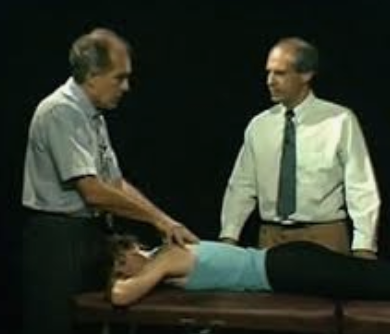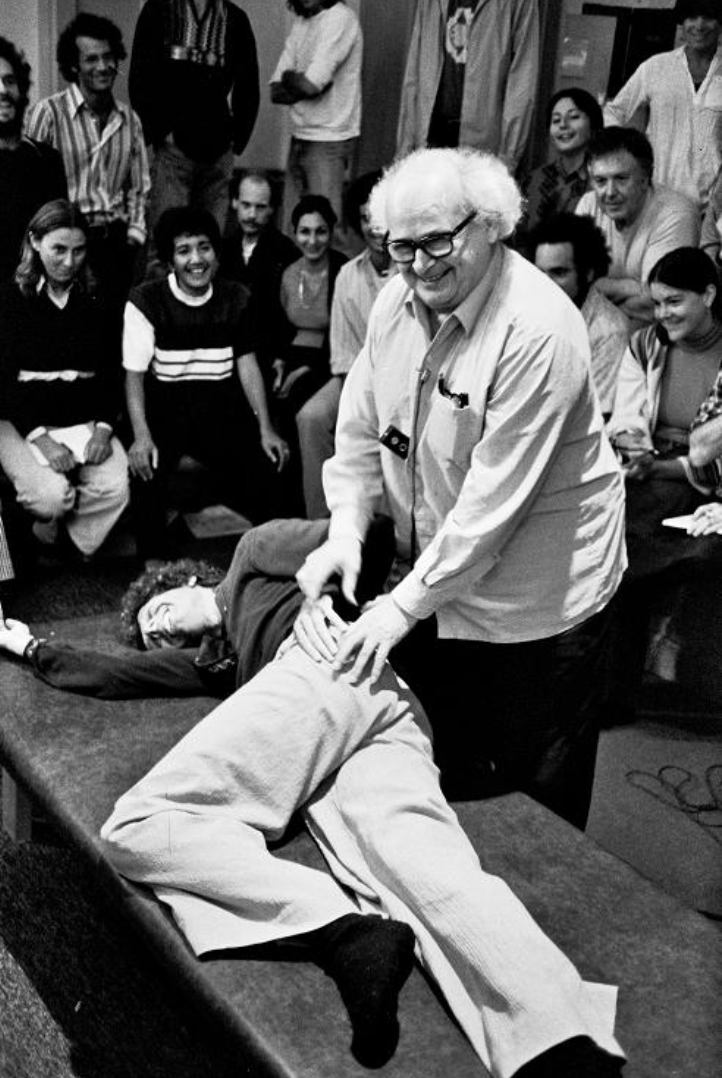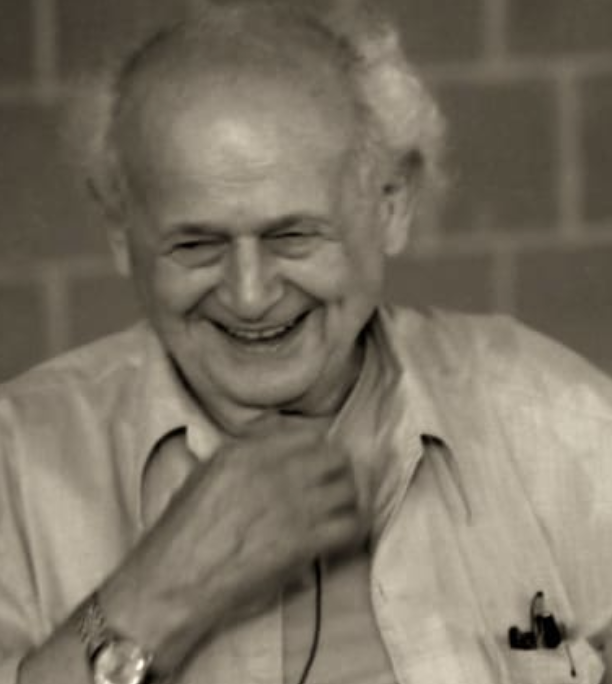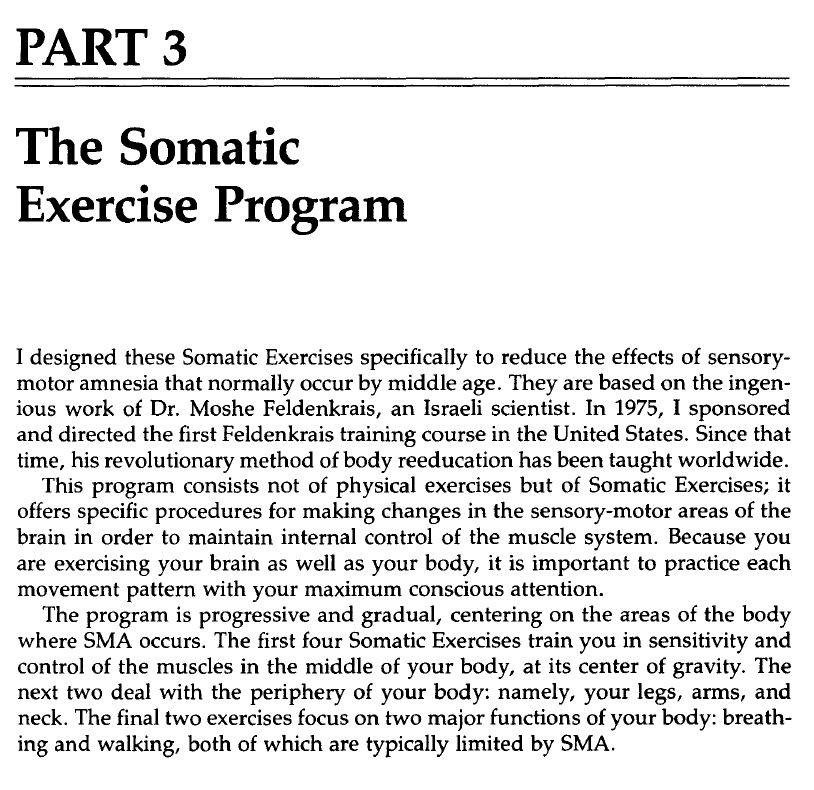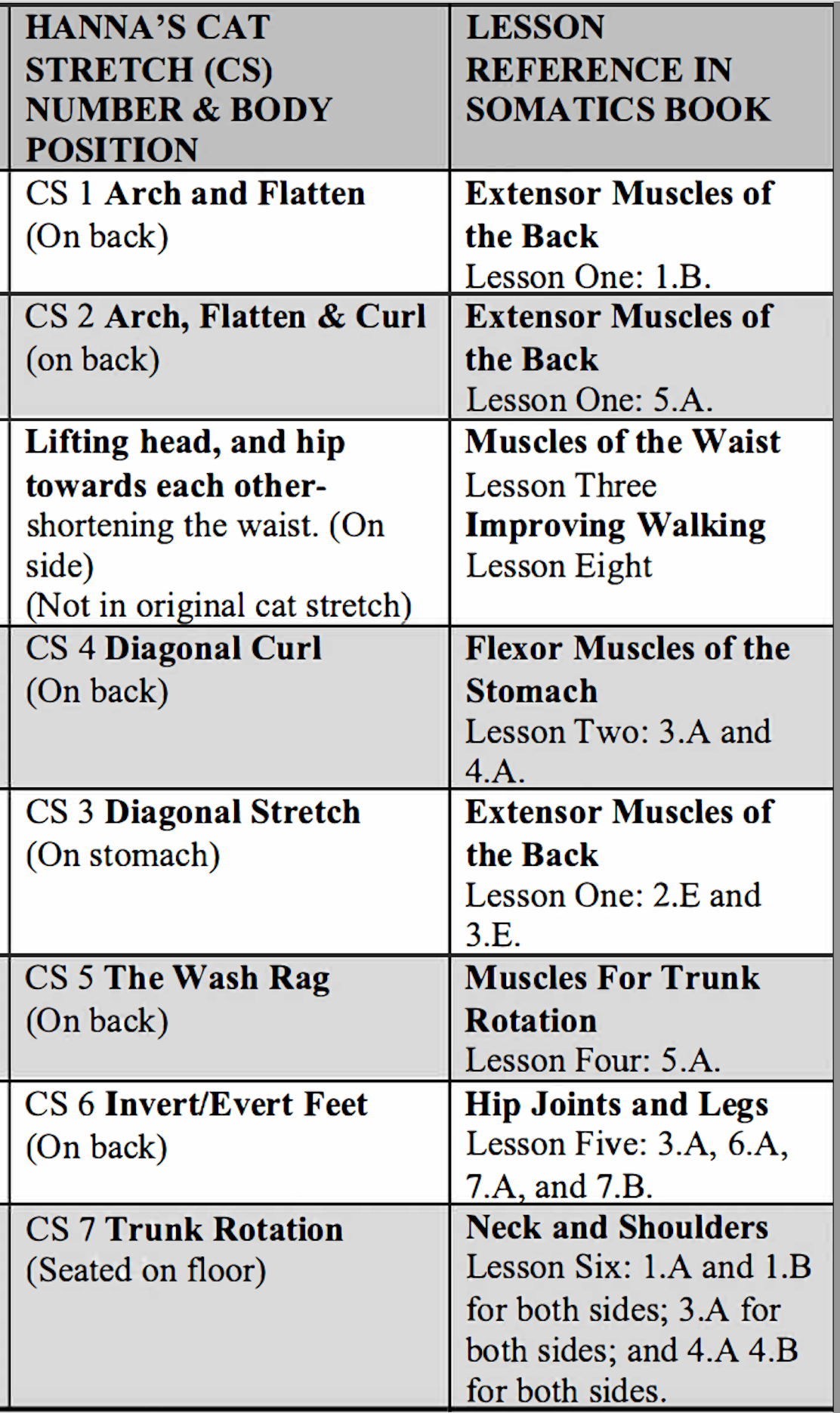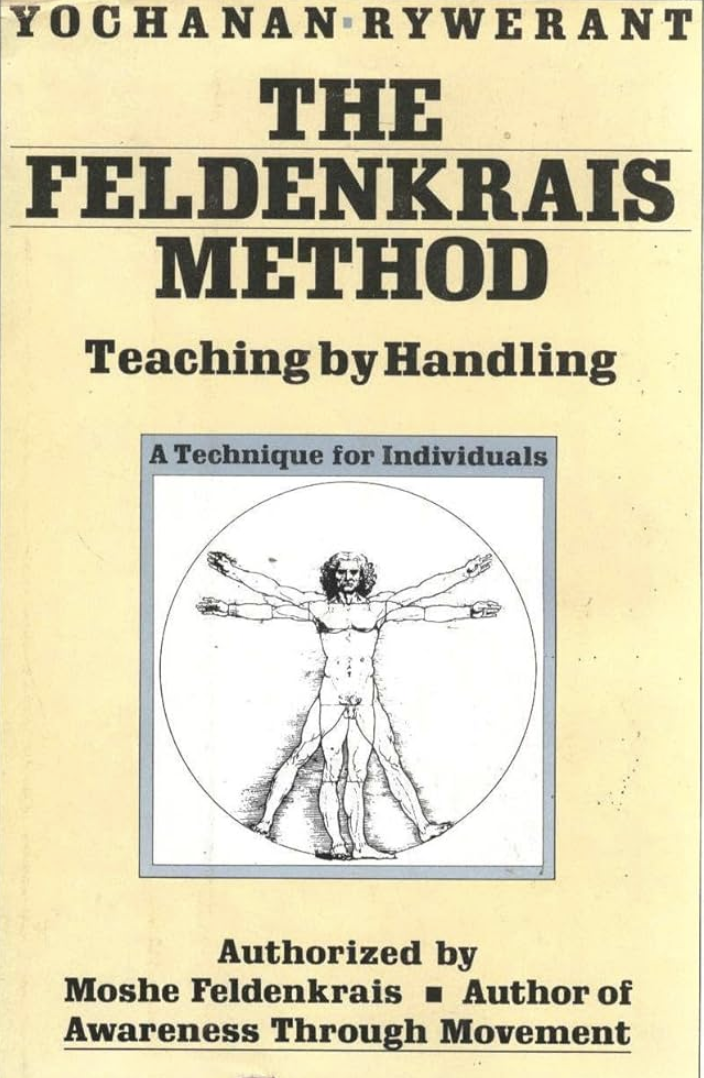Tom Hanna's revolutionary approach to somatic thought and practice includes a concise set of maintenance exercises called the Cat Stretch. His innovative methodology posited that after a thorough exploration of foundational movement lessons, individuals would require only brief, gentle movement reminders to maintain their progress. This principle was deeply integrated into his hands-on clinical pandiculation sessions, where Hanna's approach was so effective that most clients typically required just two or three sessions to significantly restore their chronic muscular and movement patterns to more optimal states.
Thomas Hanna guiding the Cat Stretch #3 for releasing the extensor muscles of the back.
Specifically, Tom Hanna developed what he called the Cat Stretch as a daily set of exercises for "maintenance of your sensory-motor control," first outlined in his seminal book, Somatics: Reawakening The Mind's Control Of Movement, Flexibility, And Health. The Cat Stretch exercises distill eight original lessons into a concise routine that has become a cornerstone of somatic bodywork. This blog will explore the origins of the Cat Stretch, examining its relationship to, and distinctions from, Feldenkrais' groundbreaking work, as well as pose some questions regarding its formation and application to somatic education.
Moshe Feldenkrais (1904-1984)
Moshe Feldenkrais demonstrating Functional Integration
Tom Hanna was perpetually captivated by individuals pioneering human potential. When he attended a workshop given by Moshe Feldenkrais in the early 1970s, Hanna described what he witnessed as seemingly miraculous. Tom Hanna then sponsored Feldenkrais' first certification trainings in the United States and personally pursued certification in Functional Integration, demonstrating his commitment to understanding and advancing innovative somatic practices.
Wendell and Tom at Yosemite National Park, 1974
Being Tom Hanna’s daughter, I have a personal perspective to add to this inquiry. I first encountered Moshe Feldenkrais during those first American summer training sessions in San Francisco when I was 16 years old. What struck me most was the unexpected twinkle in his eyes—a stark contrast to the legendary figure my father had described. Where my father spoke of Feldenkrais as a great genius and formidable miracle worker, I discovered a surprisingly warm and playful individual. Though our interactions were brief, they planted a seed of curiosity about the nuanced boundaries between Feldenkrais' methodological approach and my father's subsequent work in Somatic Education.
Origins of the Cat Stretch
Tom Hanna designed the Cat Stretch as a set of maintenance exercises, intended to be done daily after hands-on work with a practitioner, or after full exploration of the eight lessons outlined in his book Somatics. I have wondered if the term Cat Stretch is a misnomer, due to Somatic education's caution against too much stretching due to issues with the stretch reflex. However, I do not think so, as the name perfectly reflects Tom Hanna's joy and desire for playfulness. Like his mentor, Moshe Feldenkrais, Tom valued joy and ease alongside seriousness.
Introduction to the exercises in Somatics
The Cat Stretch is based on the longer somatic lessons in the back section of the book, Somatics, and was inspired by the works of Feldenkrais. Whereas Moshe Feldenkrais created over 600 Awareness Through Movement (ATM) exercises, Tom Hanna delineated only eight in his book. These lessons were focused on muscles of the:
Back
Front
Waist
Trunk
Hips and legs
Neck and shoulders
Breathing
Walking
Questions Regarding the Cat Stretch
The composition of the Cat Stretch presents a puzzle. The omission of specific lessons, such as Lesson Three (Controlling the Muscles of the Waist), which trainers often add when teaching the Cat Stretch, is perplexing. Similarly, Lessons Seven (breathing) and Eight (walking) are absent from the Cat Stretch. Notably, Lesson One (Extensor Muscles of the Back) is uniquely represented by three distinct Cat Stretch movements, while other lessons have only a single corresponding movement.
The exclusion of lesson three (side flexion) in the Cat Stretch is particularly puzzling given the importance of the Trauma Reflex in the framework of Somatics, which often affects muscles in the sides of the body. It's possible this was an oversight, or simply that Feldenkrais' work, which inspired the Cat Stretch, involved minimal side-laying exercises. Additionally, the absence of breathing (lesson 8) and walking (lesson 9) may suggest that Tom prioritized creating a succinct and easily understood routine, deliberately omitting these more complex instructions. In his article, The Myth of Aging, Tom stated that “The majority of adults in our society have retracted spines caused by the unconscious and involuntary contraction of the extensor muscles” This may be the reason Tom created three Cat Stretch exercises devoted to this common area for chronic pain.
Yochanan Rywerant (bottom left), Moshe Feldenkrais, and Thomas Hanna. San Francisco Feldenkrais trainings summer 1975-1976
Mia Segal with Moshe Feldenkrais
Mia Segal and Yochanan Rywerant
Two important people in Thomas Hanna's professional life who may have influenced his thinking on the Cat Stretch were Mia Segal and Yochanan Rywerant. During the first American Feldenkrais trainings that Hanna organized from 1975 to 1977, Segal and Rywerant—close assistants to Feldenkrais—became not just colleagues but deeply trusted friends to Tom, a relationship that would endure until his death in 1990.
What distinguished Segal and Rywerant was their intellectual openness. Despite being rigorously trained in and deeply committed to Feldenkrais' original teachings, they remained remarkably receptive to Hanna's innovative thinking. Rather than defensively clinging to orthodoxy, they engaged enthusiastically in discussions about the evolving understanding of somatic practices. This intellectual flexibility led to rich explorations of what would eventually be recognized as Hanna Somatics. Notably, their commitment to intellectual growth did not diminish their respect for Feldenkrais. Both Segal and Rywerant maintained close friendships with Tom while they continued teaching the Feldenkrais method. Today, their work is considered among the most authoritative sources on the Feldenkrais method—a testament to their ability to honor tradition while remaining open to transformative ideas.
Yochanan Rywerant (1920 - 2010)
Yochanan Rywerant published The Feldenkrais Method: Teaching by Handling in 1983, at Tom Hanna’s urging, to explain Functional Integration techniques.
Tom's foreword recognized Rywerant's success in translating the method's "intuitive clarity" into a logical framework and his achievement in transforming the "elusive subtleties" of Feldenkrais' work into a comprehensible intellectual structure.
Yochanan Rywerant demonstrating Functional Integration
Mia Segal (1930 – 2025)
Mia Segal, Tom's other close Feldenkrais colleague, broke off from the Feldenkrais association community after Moshe Feldenkrais' death in 1984, but remained connected to the work through her own version called Mind Body Studies (MBS Academy). Mia Segal taught with her daughter Leora Gaster up until her recent death in February, 2025.
Mia Segal was Feldenkrais’ closest assistant throughout his career.
What is particularly fascinating to me is that in the evolution of Mia Segal's work following Feldenkrais' death she simplified the enormous amount of Awareness Through Movement (ATM) movement lessons into eight main areas of focus. It is interesting to note that Tom’s Cat Stretch also contains only eight lessons. It makes me wonder if they may have both distilled the movements into their main components due to similar thinking.
Closing Thoughts
In looking for explanations regarding the relationship between Feldenkrais' work and Hanna's Cat Stretch, Yochanan Rywerant's writing about techniques and theories of Functional Integration (FI) and Mia Segal's mind-body studies might be a good place to begin to study how their work might have influenced Thomas Hanna's thinking.
In closing these "mew-sings", I believe questions about the Cat Stretch demand personal inquiry. Tom Hanna would undoubtedly urge individual interpretation, critical critique, and creative exploration.
To truly understand the Cat Stretch, you've got to experience it yourself. If Tom Hanna and Moshe Feldenkrais were still around, they would want you to play with it, make it your own. That's what Tom and Moshe were all about—finding your own way. Somatics, after all, is a living, breathing thing, and the Cat Stretch is just one facet of limitless somatic possibilities.


